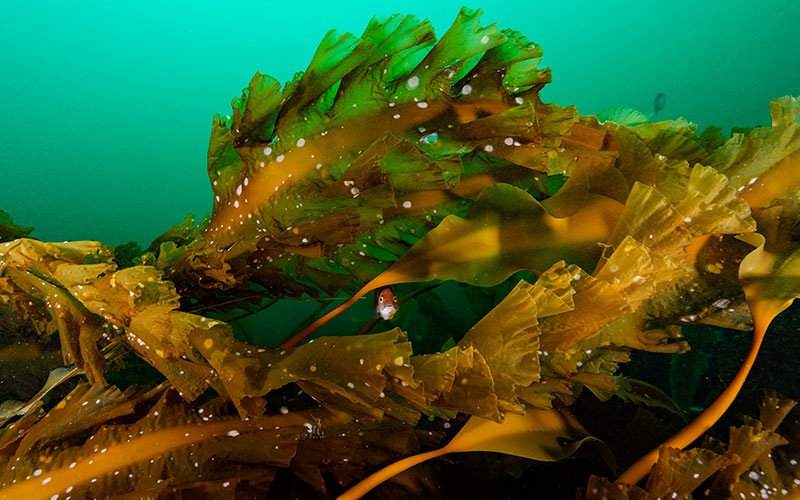
Cashes Ledge's kelp forests provide a vital habitat for marine life. Photo: Brian Skerry
CLF recently nominated the Cashes Ledge Area to become a national marine sanctuary. Protecting vital areas like Cashes Ledge is crucial to creating a healthy, thriving ocean. Marine sanctuaries are key to protecting biodiversity and building resilience to climate change and serve as undersea classrooms through research and education. If that’s something you care about, read on to learn how CLF is fighting to protect places like Cashes Ledge – and what you can do to help.
What is Cashes Ledge?
Cashes Ledge is an extraordinary underwater mountain range in the Gulf of Maine and one of the most unique ecological structures in U.S. ocean waters. This 32-mile underwater expanse of sharply rising submerged granite ridges comprises the Cashes Ledge, Sigsbee Ridge, and Parker Ridge formations. Together with the deep reaches of Cashes Basin and Ammen Basin that flank the mountain range, the Cashes Ledge Area supports a treasure trove of marine life among its diverse terrain.
On the top and flanks of its highest peak, Ammen Rock, lies the deepest, densest kelp forest on the Eastern Seaboard, the crown jewel of the Cashes Ledge area. The diverse habitats of the Cashes Ledge Area, ranging from the lush kelp forest to the rocky outcroppings to the deep muddy basins, provide a haven for a remarkable diversity of marine life. Residents include the Atlantic wolfish, the rare blue sponge, and the unusual red cod, along with seasonal visitors including humpback and sei whales.
Permanently protecting this special place would provide unparalleled scientific research and educational opportunities and one of the most comprehensive opportunities for biodiversity and climate stewardship in the Gulf of Maine.
What is a National Marine Sanctuary?
A National Marine Sanctuary is a protected area of ocean waters with outstanding ecological, historical, scientific, educational, recreational, cultural, archeological, or esthetic significance. Sanctuaries can be designated by the National Oceanic and Atmospheric Administration or Congress. They may be nominated by members of the public, including non-governmental groups (like CLF, in this case!).
The level of protection offered to sanctuaries varies based on the area’s specific needs and is ultimately determined during the designation process. As proposed by CLF, the Cashes Ledge Sanctuary would prohibit incompatible activities such as oil, gas, and mineral extraction and offshore wind development in the Sanctuary. It would also ensure that the management of the area prioritizes the National Marine Sanctuaries Act’s underlying goals of biodiversity and conservation.
The proposed sanctuary would also include a smaller, fully protected sub-area that prohibits all extractive and otherwise damaging activities. This would safeguard the biodiversity of the rare, intact kelp forest and interconnected, adjacent habitats in the face of dramatic climate impacts. The fully protected area would also provide a living laboratory to better understand the impacts of climate change in the Gulf of Maine without the confounding influences of damaging human activities.
Ultimately, what will be allowed in the Sanctuary will be determined through a multi-year, public process that will provide opportunities for engagement at each phase to ensure community-based decision making and collaboration.
Why Should Cashes Ledge be a National Marine Sanctuary?
Cashes Ledge is the crown jewel of the Gulf of Maine. Climate change and other negative human impacts pose a serious threat to this precious place. Some protections are currently in place, but those are far from comprehensive or permanent.
The Gulf of Maine’s waters are warming faster than 97% of the world’s ocean, making it one of the regions most threatened by climate change. Protecting Cashes Ledge and its remarkable diversity of wildlife and habitats would help build climate resilience in the Gulf.
Who Wants Cashes Ledge to Become a Sanctuary?
Well, we do, obviously – but we’re far from alone. Various national, state, and local NGOs, faith-based organizations, youth-serving organizations, birding and dive clubs, whale-watching companies, and the Houlton Band of Maliseet Indians submitted letters of support. Over 150 scientists submitted a declaration of support, and over 3000 members of the public signed letters and petitions.
Some people even wrote postcards with personal words of support and descriptions of what a thriving ocean means to them. One person reminisced about “seeing the wonder in my children’s eyes when they first went to the beach/ocean,” while a kid proudly explained that when they “whent scuba diveing,” [sic] they “got to see all the fish.” Another supporter said they wanted to save Cashes Ledge because they want “next generations to be able to see the beauty.”
What’s Next for Cashes Ledge and the Sanctuary Process?
The Office of National Marine Sanctuaries will go over CLF’s nomination document. At 598 pages, it might take them a bit to do a comprehensive review – up to five months. At that point, they will hopefully accept Cashes Ledge into their “inventory,” a list of sites that they’re considering for sanctuary status.
From there, a lengthy process of community engagement will follow. The Office of National Maine Sanctuaries will consult all stakeholders, including recreational boaters and businesses, fishermen, conservationists, scientists, the faith and youth communities, and Tribal Nations and Indigenous communities who have historically stewarded these waters. There will be extensive opportunities for public engagement and comment.
The Gulf of Maine is central to New England’s way of life – it’s only right that all New Englanders have the chance to make their voices heard about its future. When the opportunity arises, we hope you will speak up about what Cashes Ledge and New England’s waters mean to you.



